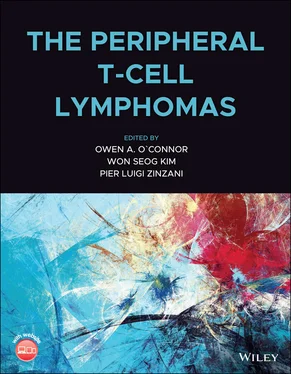1 Cover
2 Title Page The Peripheral T‐Cell Lymphomas Edited by Owen A. O’Connor, M.D., Ph.D. American Cancer Society Research Professor Professor of Medicine Department of Medicine Division of Hematology and Oncology Program for T ‐ Cell Lymphoma Research Department of Microbiology, Immunology, and Cancer Research University of Virginia Cancer Center, Charlottesville, VA, USA Won Seog Kim Sungkyunkwan University School of Medicine Seoul, Korea Pier Luigi Zinzani, M.D., Ph.D. Professor of Hematology Department of Medicine Program for Lymphomas and Chronic Lymphocytic Leukemia University of Bologna, Bologna Italy
3 Copyright Page
4 Contributors
5 About the Companion Website
6 Part I: Biological Basis of the Peripheral T‐cell Lymphomas 1 The Fundamentals of T‐cell Lymphocyte Biology Introduction General View of the Differentiation and Function of T Lymphocytes The T‐cell System as a Frame for Peripheral T‐cell Lymphoma: Taking Plasticity into Account Must Reads References 2 Mechanisms of T‐cell Lymphomagenesis Introduction Oncogenic Events in the Transformation of T or Natural Killer Cells Conclusion Acknowledgement Must Reads References 3 Epigenetics of T‐cell Lymphoma Introduction Epigenetic Pathways Altered in T‐cell Lymphoma Epigenetic Changes Within Specific T‐cell Lymphoma Subtypes Established and Emerging Drugs Targeting the T‐cell Lymphoma Epigenome Combination Therapies Involving Epigenetic Targeting Agents Future Directions Must Reads References 4 Animal Models of T‐cell Lymphoma Introduction Angioimmunoblastic T‐cell Lymphoma Anaplastic Large T‐cell Lymphoma Human T‐cell Lymphotropic Virus Type 1 Adult T‐cell Leukemia/Lymphoma Cutaneous T‐cell Lymphoma Enteropathy‐associated T‐cell Lymphoma Conclusion Must Reads References
7 Part II: Epidemiology and Classification of the PTCL 5 Geographic Distribution of the Peripheral T‐cell Lymphomas Historical Perspective Epidemiology Conclusion Must Reads References 5.A 2017 World Health Organization Classification of Mature T- and NK-cell Neoplasms 6 Classification of the Peripheral T‐cell Lymphomas Introduction Angioimmunoblastic T‐cell Lymphoma and Other Nodal Lymphomas of T follicular Helper Cell Origin Peripheral T‐cell Lymphoma Not Otherwise Specified Anaplastic Large‐cell Lymphomas Adult T‐cell Leukemia/Lymphoma Intestinal T‐cell Lymphomas Hepatosplenic T‐cell Lymphoma Mycosis Fungoides Sézary Syndrome Primary Cutaneous CD30‐positive T‐cell Lymphoproliferative Disorders Primary Cutaneous Gamma–Delta T‐cell Lymphoma Primary Cutaneous CD8+ Aggressive Epidermotropic Cytotoxic T‐cell Lymphoma (Provisional) Primary Cutaneous CD4+ Small/Medium T‐Cell Lymphoproliferative Disorder (Provisional) Primary Cutaneous Acral CD8+ T‐cell Lymphoma (Provisional) Large Granular Lymphocytic Leukemia T‐cell Prolymphocytic Leukemia NK‐cell Lymphomas Must Reads References 7 Molecular Classification of the Peripheral T‐cell Lymphomas Introduction T‐cell Development and Activation: An Overview T‐cell Receptor Signaling Derivation of Diagnostic Signatures for Molecular Classification of Peripheral T‐cell Lymphomas Angioimmunoblastic T‐cell Lymphoma and Other T Follicular Helper‐derived Malignancies Anaplastic Large‐cell Lymphomas Adult T‐cell Leukemia/Lymphoma Peripheral T‐cell Lymphoma Not Otherwise Specified Hepatosplenic T‐cell Lymphoma Extranodal natural killer/T‐cell Lymphoma Cutaneous T‐cell Lymphomas Conclusion Must Reads References
8 Part III: Discrete Clinical Subtypes of PTCL (Unique Epidemiology, Therapy and Management) 8 Peripheral T‐cell Lymphoma Not Otherwise Specified Introduction Epidemiology, Risk Factors, and Clinical Characteristics Basic Principles of Disease Biology Prognostic Tools Frontline Therapy Management of Relapsed or Refractory Disease Future Directions Must Reads References 9 Angioimmunoblastic T‐cell Lymphoma Introduction Clinical and Biological Presentation Epidemiology and Risk Factors, Disease Incidence and Prevalence Basic Principles of Disease Biology Management of Disease in the Front Line Management of Relapsed or Refractory Disease Future Directions Must Reads References 10 The Spectrum of Anaplastic Large‐cell Lymphoma Introduction Epidemiology and Risk Factors Disease Incidence and Prevalence Basic Principles of Disease Biology Management of Disease in the Front Line Management of the Relapsed or Refractory Patient Future Directions Acknowledgement Must Reads References 11 Human T‐cell Lymphotropic Virus Type 1 Positive Adult T‐cell Leukemia/Lymphoma Epidemiology and Disease Incidence Basic Principles of Disease Biology CCR4 and Adult T‐cell Leukemia/Lymphoma Clinical Features of Adult T‐cell Leukemia/Lymphoma Prognosis and Prognostic Index of ATLL Front‐line Management of Aggressive Adult T‐cell Leukemia/Lymphoma Front‐line Management of Indolent ATLL Management of Relapsed or Refractory Patients Future Directions Must Reads References 12 Natural Killer/T‐cell Lymphomas Introduction Management of Newly Diagnosed Treatment‐naïve Patients Consolidation Treatment with Hematopoietic Stem‐cell Transplantation Management of Relapsed or Refractory Disease Future Directions Must Reads References 13 T‐Prolymphocytic Leukemia Introduction Must Reads References 14 Large Granular Lymphocyte Leukemia Introduction Epidemiology and Risk Factors Prevalence of Concomitant Disorders Basic Principles of Disease Biology Management of Disease in the Front Line Management of Relapsed or Refractory Disease Future Directions Funding Must Reads References 15 Gamma–Delta T‐cell Lymphomas Introduction Epidemiology and Risk Factors Biology of Primary Cutaneous Gamma–Delta T‐cell Lymphoma Must Reads References 16 Enteropathy‐Associated and Monomorphic Epitheliotropic Intestinal T‐cell Lymphomas Introduction Enteropathy‐associated T‐cell Lymphoma Refractory Celiac Disease Monomorphic Epitheliotropic Intestinal T‐Cell Lymphoma Must Reads References 17 Hepatosplenic T‐cell Lymphomas Epidemiology and Disease Incidence Basic Principles of Disease Biology Clinical Features Management of Disease in the Front Line Management of the Relapsed or Refractory Disease Splenectomy Future Directions Funding Must Reads References 18 Cutaneous T‐cell Lymphoma Introduction Epidemiology and Risk Factors Basic Principles of Disease Biology Clinical, Pathologic, and Immunophenotypic Findings Management of Front‐Line Mycosis Fungoides/Sézary Syndrome Management of Relapsed or Refractory Disease with Mycosis Fungoides/Sézary Syndrome Front‐Line Management of Non‐mycosis Fungoides Cutaneous T‐cell Lymphomas Management of Relapsed or Refractory Non‐mycosis Fungoides Cutaneous T‐cell Lymphomas Future Directions Must Reads References 19 Other Rare Subtypes of Peripheral T‐cell Lymphoma Introduction Chronic Lymphoproliferative Disorders of Natural Killer Cells Epstein–Barr Virus‐associated T‐cell and NK‐cell Lymphoproliferative Disorders of Childhood Future Directions Must Reads References
9 Part IV: Treatment of the PTCL 20 Standard Front‐line Therapies Introduction Initial Workup and Risk Stratification Front‐line Therapy Must Reads References 21 Approved Agents in the Relapsed or Refractory Setting, Excluding Brentuximab Vedotin Introduction Challenges in Developing New Drugs in Peripheral T‐cell Lymphomas Drugs Approved by the US Food and Drug Administration with an Indication in Relapsed/Refractory Peripheral T‐cell Lymphoma Drugs Approved by the US Food and Drug Administration But Without An Indication in Relapsed/Refractory Peripheral T‐cell Lymphoma Drugs Approved by International Regulatory Agencies, Not Including the United States, that Carry an Indication in Relapsed/Refractory Peripheral T‐cell Lymphoma Conclusion Must
Читать дальше












